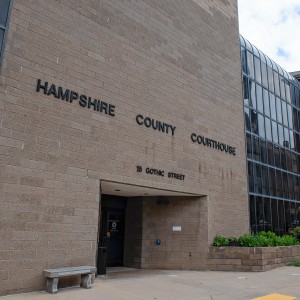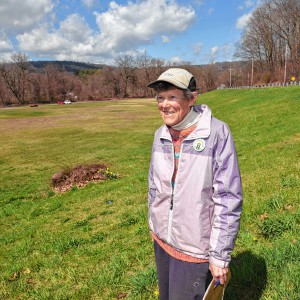Vines and wines at Quabbin Sky Vineyard
| Published: 01-24-2022 3:08 PM |
When I was growing up in southern Pennsylvania, I used to see plenty of grape arbors in my neighborhood. Some grew grapes for the landscaping affect, others I’m sure ate and made their grapes into wine.
Joyce and Phillip Wiley purchased their property in New Salem in 2004. Joyce Wiley shared the story of how they came to be vintners as well as good tips on growing grapes for wine.
“One of the first things Phillip did when we got here was to jump on the tractor and mow all the weeds around the vines. We figured we’d stake them up and see what we have in the spring. I was literally still unpacking,” said Wiley.
After some convincing by their neighbor and former property owner, Fritz Von Maning, the couple went on to create Quabbin Sky Vineyard in 2010. The vineyard is named after their border collie Sky. They are also located near the Quabbin, gate 18.
Wiley was clear that they “didn’t have a clue (about growing grapes for wine). We didn’t even drink wine,” when they purchased the property. “It’s a constant learning process, you never stop learning. People often ask what our best year was. I always say ‘this year.’”
Wiley said as the plants have grown older they have learned more and are always working with improving the quality of the grapes, and thus their wines. The wines the couple produce have garnered world-wide attention. “I just had some folks from Israel here today. We get people from all over,” she said.
The vines the couple grow are notable in that they have been DNA identified as Aurore and Totmur varieties, which date back to 1860 from France. “We were the first people in the U.S. to ever send leaves of these varieties to the labs for identification. They have never been crossed (with any other variety),” said Wiley.
Wiley said she and her husband now “just can’t stop purchasing rows and making wines. We have 10 we admit to,” she said wryly.
Article continues after...
Yesterday's Most Read Articles
 Greenfield man arrested in New York on murder charge
Greenfield man arrested in New York on murder charge
 Man allegedly steals $100K worth of items from Northampton, South Deerfield businesses
Man allegedly steals $100K worth of items from Northampton, South Deerfield businesses
 Greenfield Police Logs: April 9 to April 17, 2024
Greenfield Police Logs: April 9 to April 17, 2024
 Former Leyden police chief Daniel Galvis charged with larceny
Former Leyden police chief Daniel Galvis charged with larceny
 Shea Theater mural artist chosen out of 354 applicants
Shea Theater mural artist chosen out of 354 applicants
 Millers Meadow idea would ‘completely transform’ Colrain Street lot in Greenfield
Millers Meadow idea would ‘completely transform’ Colrain Street lot in Greenfield
The couple worked with the University of Massachusetts in Belchertown to learn to grow their grapes. Wiley said UMass has a research vineyard where they were able to volunteer time to augment their learning. “They took us under their wing,” said Wiley, who added they learned a great deal from Cornell University as well and cites them as an excellent resource for information and videos about growing grapes.
The couple do not use any type of pesticides and very few, and only non-toxic chemicals, to grow their grapes and for making wines. “We are the only ones I know of that don’t use chemicals,” she said.
All of their wines are aged one year. “We use glass and stainless steel. We don’t even use oaky things,” said Wiley.
A small amount of sulfite is use to kill bacteria in the wines she said.
Tips for growing grapes for wine
If you are interested in growing your own grapes, Wiley said the first thing to consider is “know where you live. What is your region? Match grape varietals to the zone you live in.”
Wiley said sometimes people just want to grow their favorite grape variety, but it doesn’t necessarily coincide with regional weather and conditions. While there are plenty of suppliers for varieties and supplies, Wiley uses Double A Vineyards which is located in Fredonia, New York.
Wiley said you can purchase 1-year-old plants as she does or “spend a lot of money on 3-year-old plants.” Grape plants fully mature for use in wine at four years. Wiley said she likes to use 1-year-old plants to allow their roots to establish better. As the vines shoot up, they get smaller shoots that come off of them. “Pick those off. This is called ‘over-cropping,’” she said.
This technique allows for a good strong main shoot to grow. You naturally want to have healthy soil that has good drainage, she said. Wiley said in terms of watering, you need to water every day. “Unless of course you have a year like we did last year with 10 inches of rain in one month.”
Grape vines go dormant around November and the plant should be pruned down annually once dormant, Wiley said, as this reduces the chance of disease. When the runners start to sprout in the spring you want to train the healthiest two shoots up an arbor in a “T” shape known as the bilateral “courdun.” Nodes will grow out of the vines with buds that will flower and then produce grapes.
Fertilization depends on your site. “You definitely have to have a soil test first,” said Wiley.
She doesn’t use pesticides as she has never noted any pests. Wiley does use non-toxic fungicides to combat black rot, powdery mildew, etc. Wiley said the products they use are safe enough to apply without a mask and should be applied at the first sign of mildew, otherwise you may never have a healthy plant again.
Wiley said a great deal of work goes into maintaining the grapes with constant weeding and mowing to reduce the possibility of disease and pests. Wiley’s grapes are an “early to ripen” variety. “I don’t get bud break until after May, about the first week of June. The grapes set after the bloom. The little petals open and then you know you are going to have a grape,” she said. Wiley said the plants go through growth spurts and rests for the next few months and that she is usually picking grapes around September 10.
She then tests the grapes for their sugar content using a portable refractometer. This allows her to know when producing wines how much sugar to add. Wiley said it is very important to use cane sugar as “cane sugar is closest to the grape sugar. It just accepts it,” she said. The sugar content must be managed to also manage the alcohol content she said.
The sugar content in grapes is known as the “brick.” The brick should either be, or be brought up to be a measure of 20 to 24 on the refractometer. This produces a wine that has a 12 percent alcohol content.
Wiley has a small book she has used from the beginning that contains charts that help her determine the factors of wine making. She emphasized it is critical to keep learning and researching if you want to grow grapes for wine.
Lastly, everything needs to be as clean as possible, from the grounds around the vines to all materials used to produce wines Wiley said.
Quabbin Sky Vineyard is located at 8 Hunt Road, New Salem. Phone: 978-544-6543. Webiste: www.QuabbinSkyVineyard.com
Cris Carl is an avid local gardener, licensed therapist and certified herbalist. She is an experienced journalist who has written for the Recorder for many years. You can reach her at cstormfox57@gmail.com.

 Speaking of Nature: Indulging in eye candy: Finally, after such a long wait, it’s beginning to look like spring is here
Speaking of Nature: Indulging in eye candy: Finally, after such a long wait, it’s beginning to look like spring is here Celebrating ‘Seasonings’: New book by veteran preacher and poet, Allen ‘Mick’ Comstock
Celebrating ‘Seasonings’: New book by veteran preacher and poet, Allen ‘Mick’ Comstock Faith Matters: How to still the muddy waters of overthinking: Clarity, peace and God can be found in the quiet spaces
Faith Matters: How to still the muddy waters of overthinking: Clarity, peace and God can be found in the quiet spaces A time for every purpose under heaven: Free sing-a-long Pete Seeger Fest returns to Ashfield, April 6
A time for every purpose under heaven: Free sing-a-long Pete Seeger Fest returns to Ashfield, April 6
